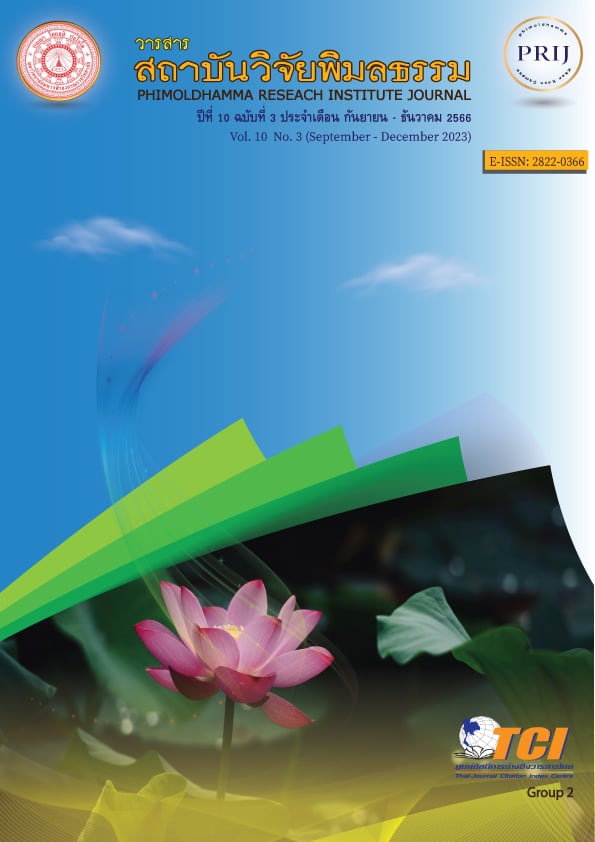The Relationship Between Adversity Quotient of School Administrators and Healthy Organization of Schools under the Krabi Primary Educational Service Area Office
Keywords:
Adversity Quotient, Healthy Organization, Primary EducationAbstract
The objectives of this research were to study 1) adversity quotient of school administrators under Krabi Primary Educational Service Area Office; 2) healthy organization of schools; and 3) the relationship between adversity quotient of school administrators and healthy organization of schools. The research was correlational research, sample consisted of 127 school administrators under Krabi Primary Educational Service Area Office, were determined by the Krejcie and Morgan’s Sample Size Table, and then using stratified random sampling based on school size. The employed research instrument was a rating scale questionnaire on adversity quotient of school administrators and healthy organization of school, with reliability coefficients of .90 and .95. Statistics employed for data analysis were the frequency, percentage, mean, standard deviation and Pearson’s product moment correlation coefficient.
The research results were as follows:
1. The overall adversity quotient of school administrators was at the high level, and the aspect with the highest level was tolerance to the protractedness of the problem, while the aspects that were at the high level were the perception of the impact scope of the problem, perception of causes and responsibilities, and control of the situation.
2. The overall healthy organization of schools was at the high level, and the aspect with the highest level was open working atmosphere, while the aspects that were at the high level were colleague leadership, adaptability, good support and resource allocation, and efficiency communication.
3. Adversity quotient of school administrators and healthy organization of schools had a positive correlation at the high level with the correlation coefficient of .84, which was significant at the .01 level.
References
จิณณวัตร ปะโคทัง. (2562). การสื่อสารในสถานศึกษายุคดิจิทัล. วารสารสมาคมพัฒนาวิชาชีพการบริหารการศึกษาแห่งประเทศไทย, 1(1), 125-132.
นรากร มั่นแก้ว. (2566). ปัจจัยที่ส่งผลต่อสุขภาพองค์กรของโรงเรียน สังกัดสำนักงานเขตพื้นที่การศึกษาประถมศึกษาตาก เขต 1. วารสารวิชาการ ครุศาสตร์สวนสุนันทา, 7(1), 43-55.
ธันยพร เฟื่องวัฒนศิริ. (2557). การศึกษาสุขภาพองค์การของสถานศึกษา สังกัดสานักงานเขตพื้นที่การศึกษาประถมศึกษานครราชสีมา เขต 2. การประชุมวิชาการระดับบัณฑิตศึกษาแห่งชาติ ครั้งที่ 31, 16 กรกฎาคม 2557, (หน้า 246-254). บุรีรัมย์: มหาวิทยาลัยราชภัฏบุรีรัมย์.
วิไลวรรณ ทองดี. (2558). ความฉลาดทางอารมณ์และความสามารถในการเผชิญและฟันฝ่าอุปสรรคของผู้บริหารสถานศึกษา สังกัดสำนักงานเขตพื้นที่การศึกษาประถมศึกษาอุดรธานี. (วิทยานิพนธ์ศึกษาศาสตรมหาบัณฑิต). อุดรธานี: มหาวิทยาลัยราชภัฏอุดรธานี.
สราวุธ ตรีโรจน์พร. (2559). ความสามารถในการเผชิญปัญหาและฟันฝ่าอุปสรรคของผู้บริหารโรงเรียน สังกัดสำนักงานเขตพื้นที่การศึกษามัธยมศึกษา ในภาคตะวันออกเฉียงเหนือตอนบน. มนุษยศาสตร์และสังคมศาสตร์ มหาวิทยาลัยพะเยา, 4(3), 28-37.
สุธาศินี ธนสงวนวงศ์. (2562). ความคิดเห็นของบุคลากรเกี่ยวกับแนวทางการพัฒนาองค์กรสุขภาวะในสำนักงานสาธารณสุขจังหวัดชลบุรี. (วิทยานิพนธ์การจัดการมหาบัณฑิต). ชลบุรี: มหาวิทยาลัยบูรพา.
สำนักงานเขตพื้นที่การศึกษาประถมศึกษากระบี่. (2566). แผนปฏิบัติการประจำปีงบประมาณ 2566. กระบี่: สำนักงานเขตพื้นที่การศึกษาประถมศึกษากระบี่.
อมรรัตน์ จินดา. (2558). สภาพปัญหาและแนวทางส่งเสริมการใช้เทคโนโลยีสารสนเทศและการสื่อสารเพื่อการศึกษาสาหรับสถานศึกษาในสังกัดสานักงานเขตพื้นที่การศึกษาประถมศึกษานครปฐม เขต 2. วารสารมนุษยศาสตร์ สังคมศาสตร์ และศิลปะ มหาวิทยาลัยศิลปากร, 9(1), 395-407.
อมรวรรณ เวชกามา. (2563). ความฉลาดในการแก้ไขอุปสรรคของผู้บริหารสถานศึกษากับบรรยากาศองค์การของโรงเรียน สังกัดสำนักงานเขตพื้นที่การศึกษาประถมศึกษากรุงเทพมหานคร. (วิทยานิพนธ์ศึกษาศาสตรมหาบัณฑิต). กรุงเทพฯ: มหาวิทยาลัยศิลปากร.
Burton, J. (2010). WHO Healthy Workplace Framework and Model: Background and Supporting Literature and Practice. Geneva, Switzerland: World Health Organization.
Beck, D. E., & Cowan, C. C. (1996). Spiral Dynamics. Mastering values, leadership, and change. Cambridge, MA: Blackwell Business.
Krejcie, R. V. & Morgan, D. W. (1970). Determining sample sizes for research activities. Educational and Psychological Measurement, 30, 607-610.
Hoy, W. K., and Miskel, C. G. (1991). Educational Administrati on Theory, Research, and Practice. (3rd ed.). New York: Random House.
Milstein and Belasco, J. A. (1973). Educational Administration and the Behavioral Science: A System Perspective. Boston: Allyn and Bacon.
Stoltz, P. G. (1997). Adversity Quotient: Turning Obstacles into Opportunities. Retrieved from https://www.scirp.org/reference/referencespapers?referenceid=2612828





